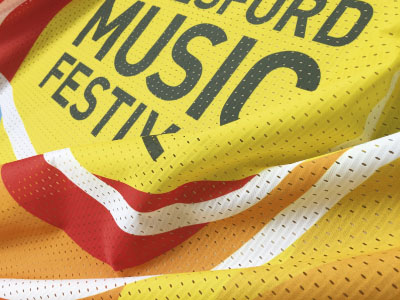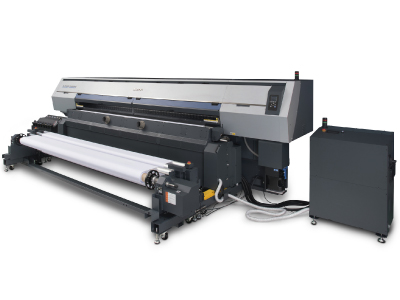Mimaki’s TX500P includes an infrared heating unit to fix the colour as it’s printed
A number of different print technologies are viable for soft signage but which is the most appropriate? Nessan Cleary considers the options.
Over the last five years or so there’s been a steady rise in the market for printing display signage on textiles – so-called soft signage. The typical markets include exhibition graphics as well as lightboxes, retail point of sale displays, window blinds and wall coverings, plus banners and flags. Textiles are generally the preferred option mainly because they are easy to handle and robust enough that the prints can stand being creased. They can even be washed and re-used. Most fabrics are also fairly light, which makes it easier to install displays, and the prints can be rolled up and posted so there is none of the cost involved in sending an installation team around.
Textiles can even tick the sustainability box as fabric is generally easier to recycle than vinyl. That said, the environmental benefits will largely depend on the inks used to make the print. Some inks, such as dye sub and latex are water-based, while others will require a coating that may not be quite as green as the fabric itself.
Using existing equipment
Solvent, latex or UV printers can all be used to print to textiles. The main limitation is printing to mesh materials, where the inks pass straight through the substrate and make a mess of the platen. Otherwise, there is a good choice of polyester-based materials designed to work with these printers. For example, Steve Collins, Agfa UK’s wide format sales manager, says that several of his customers are printing point of sale display graphics on Agfa’s printers with its standard UV inks. Collins says that Berger’s Samba material is widely used as well as Agfa’s own Coatex, adding: ‘There’s no issue with drying and the colours are vibrant.’
Durst even offers its customers the option of a UV ink that’s designed for printing to textiles. The Flexible Low Tack FLT ink is compatible with all of Durst’s Rho UV printers and includes CMYK plus light cyan and light magenta colours. Peter Bray, managing director of Durst UK, says that conventional UV inks can suffer hairline cracks if they’re continuously folded or taken in and out of aluminium frames, which affects the adhesion. He added ‘The FLT ink doesn’t have that issue. It works also with paper and self adhesive substrates.’

Durst UK managing director Peter Bray
There are also quite a few companies using HP Latex printers for soft signage. Jane Rixon, channel business manager for HP wide format, says that the current third generation inks have been designed to work with textiles because the company realised that that was a growing market demand. The latex inks can print directly to cotton, uncoated canvas and bond paper. Ms Rixon said ‘The inks sit on the surface of the material so you don’t always need a coating for latex, which means that you can look at less expensive materials.’ Many of the HP printers have also dealt with the problems associated with mesh materials by having removable platens to collect the excess ink.
Dye sublimation
The main advantage of dye sublimation is that the inks are forced right into the fibres of the fabric rather than sitting on top. This leads to brighter, more vibrant colours that are more resistant to weather, washing and ambient conditions. It also means that the material retains its look and feel, important in some décor applications such as cushions or curtains, as well as some signage use such as flags.
In addition, Nick Decock, marketing manager for Mutoh Europe says that dye sub inks are cheaper per litre than ecosolvent or UV inks, adding: ‘I think that if you have the volume then you can make a better business case for dye sub.’ Mr Bray points out that some print buyers specify water-based inks, either to satisfy their own environmental targets or to avoid the risk of odour that is sometimes associated with UV prints.
Until recently, the standard approach to dye sublimation has been to print first to a transfer paper and then to use a calender or heat press to sublimate the inks from the paper to the textile. This method works well with a range of polyester-based materials, without requiring any sort of coating. It is particularly useful for stretchable materials, which are sometimes used for curved lightboxes. Mr Decock points out that this method can also be used to transfer images to objects such as mugs or phone cases. However, you will need to factor in somewhere between £20,000 and £60,000 for a heat press.
In recent years the alternative, printing direct to textile, has improved greatly. Stephen Woodall, Hybrid Services sales manager for textile printers, said that transfer dye sublimation is too long winded and expensive for soft signage work but that direct dye sublimation is starting to become more popular, mainly because the cost per square metre is lower. He said that direct printing usually requires media with a coating but it will be a light liquid coating to stop the ink from bleeding or wicking which will not affect the handling of the material. Most, but not all, of these printers also include an infrared fixation unit so that there is no need for further processes.
What’s available
Mutoh has just launched a new dye sublimation printer, the ValueJet 1948WX. This is a 1.9 m wide printer designed to print sublimation inks to transfer paper, although it can also print direct to some fabrics. It has four printheads and can print at up to 117 sqm/hr. Mutoh also sells a 1.9 m wide direct to textile printer, the VJ1938TX, which has a choice of inks for printing to different materials but requires a calender to fix the colours. Mutoh also sells a 1.6 m wide dye sub printer for transfer papers, the VJ1638WX.
Roland has produced the Texart range of dye sublimation printers, which use an eight colour inkset including CMYK plus light cyan, light magenta, orange and violet. Roland has also partnered with Sabur, which has developed dye sublimation inks that effectively convert the XF640 solvent printer into a direct to textile printer.

Corporate interior decor example by Mimaki
Mimaki has several textile printers, including the TS500P, a 3.2 m wide machine capable of 180 sqm/hr. It is designed to print to transfer paper and uses Mimaki’s Sb310 dye sub inks with blue, magenta, yellow and black. There is a variant for printing direct to textiles, the TX500P, which includes an infrared heating unit to fix the colour as it is printed. It uses the Sb320 inks and is available with either four colours, which can produce 130 sqm/hr, or with six, that is capable of 105 sqm/hr.
Mtex specialises in textile printers, with three being suitable for sign and display applications. All of these are designed to print direct to textiles and include infrared fixation units. The Mtex Blue is a 1.8 m wide printer capable of 55 sqm/hr. Resolution ranges from 360 dpi to 1080 dpi with four colours. There are two 3.2 m wide printers. The 5032HS offers resolution from 300 dpi up to 1200 dpi and a choice of four, six or eight colours. It can produce up to 120 sqm/hr and there is a choice of reactive, acid, disperse and pigment inks. The 5032 Pro has higher resolution, from 540 dpi to 1440 dpi, with four colours and a print speed of 58 sqm/hr.

Mtex soft signage example
Durst makes a number of dye sublimation printers for graphics work. This includes the Rhotex 180 TR, a 1.8 m wide machine that mainly prints to transfer paper. However, Durst also makes a number of printers designed to print direct to fabric. The Rhotex 322 is a 3.2 m wide printer capable of 140 sqm/hr, while the Rhotex 500 is one of the few 5 m wide printers around, with a Production mode speed of 125 sqm/hr. There is also a high speed Rhotex HS printer, also 3.2 m wide, which is capable of producing up to 430 sqm/hr.
The Rhotex series include heaters to dry the inks to increase the printing speed but not fixation heaters to complete the sublimation process. Mr Bray explained ‘We would have to slow the printer down and wouldn’t have the same control so we suggest that you calender offline.’ He also points out that the Durst machines are expensive and most customers have built up a volume of work with cheaper models and so already have a calender unit.
EFI has developed the Vutek FabriVu range, based on print technology from the Italian company Reggiani that it bought back in 2015. There are two models: 1.8 m and 3.4 m wide, with speeds of 400 sqm/hr and 500 sqm/hr respectively. They are designed to print direct to textiles as well as transfer paper and use a four-colour dispersed dye inkset with resolution up to 2400 dpi.
Conclusion
Ultimately the choice of print technology for textiles really comes down to volume. There are plenty of substrates designed for use with solvent and UV printers and no reason not to use an existing printer for low volume soft signage work. Equally, the latex printers are a good option for mid-volume use and several substrates have been qualified specifically for these printers. But if you have the volume to justify buying an additional printer then it clearly makes sense to go for a dye sublimation machine, which should produce brighter colours with a wider choice of materials and lower running costs. Just to underscore the point, the bulk of the newer dye sub printers are 3.2 m wide and designed for industrial production, which clearly indicates that the soft signage market is now reaching the sort of level that up till now we have only seen for UV printers.





